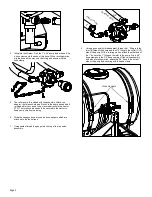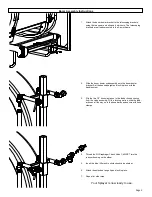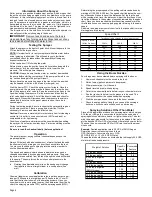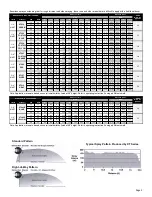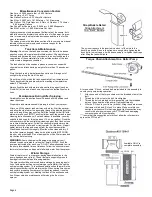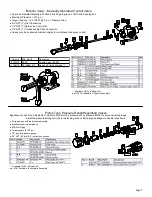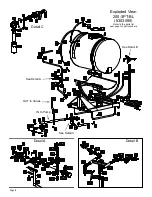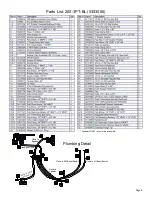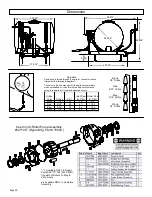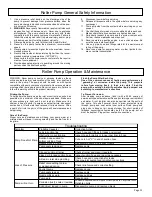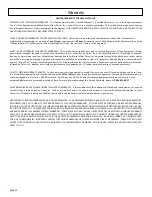
Page 4
Information About the Sprayer
Roller pumps are positive displacement pumps, which means that
the entire solution being pumped must go somewhere or the pump
will break. In this roller pumping system, solution is drawn from the
tank and forced to a planned source, such as boom nozzles or hand-
gun. The pressure is controlled by a pressure relief valve, which is a
spring-loaded device that controls the amount of fluid bypassed
(recirculated) to the tank. The gray handle is to be tightened to in-
crease pressure and loosened to decrease pressure.
The ‘directo-valve’ is the on/off control which allows the operator to
manually control the solution going to the boom.
IMPORTANT:
Remove tank lid and be sure the tank is
clean and free of any foreign material. Rinse tank out of any
tank residue before filling with water to test.
Testing the Sprayer
Attach the sprayer to the tractor 3 point hitch. Mount the pump to the
PTO and affix the torque chain.
NOTE:
It is important for to test your sprayer with plain water before
actual spraying is attempted. This will enable you to familiarize
yourself and check for leaks without the possibility of losing any
expensive chemicals.
Fill the tank about 1/2 full with plain water.
Before starting, open the suction line valve (located underneath the
carrier frame), turn the relief valve handle out to lower the line
pressure. This will help prime the pump.
CAUTION:
Always be sure that the water (or solution) has reached
the pump before starting your sprayer. If the pump is allowed to run
dry, serious damage to the pump will result.
Always have the pressure line open to the tips so that the air which
may be trapped in the line will be forced (or purged) out.
Start the tractor PTO. Check the entire system for leaks. Once the
pump is primed, the pressure may be increased by turning the han-
dle of the pressure relief valve in. Keep the pressure line open to the
tips when setting the pressure. Set the pressure and then lock the
relief valve handle in place. Shut off the directo-valve and check for
leaks again. Pressure will increase when the pressure line valve is
closed and then return to the preset pressure when the valve is
opened again.
During the testing period, be sure to observe the spray pattern given
by the spray nozzles. If there is any pattern distortion, it will be
necessary to remove and clean the affected tips.
Caution:
Never use a metal object or other sharp item for cleaning a
nozzle tip. It is better to use a nozzle brush (NOT wire brush) or
compressed air for tip cleaning.
Conditions of weather and terrain must be considered when setting
the sprayer. Do not spray on windy days. Protective clothing must be
worn in some cases
Be sure to read the chemical label(s) before application!
Operation
The performance of any agricultural chemical depends upon the
proper application.
Always fill the tank with a desired amount of water first and then add
the chemical slowly, mixing as you pour the chemical into the tank.
You may use the handgun to spraying into the solution in order to
mix the chemical and water.
The speed and pressure charts shown indicate the rates can be
changed considerably by changing speed and pressure. The pump-
ing system draws solution from the tank through the strainer/filter and
to the pump. The pump forces the solution under pressure to the
boom nozzles.
Rotating the adjustable nozzle tip on the handgun will change
the tip pattern from a straight stream to a cone pattern (fine
mist)
Calibration
Chemical labels may show application rates in gallons per acre, gal-
lons per 1000 square feet or gallons per 100 square feet. You will
note that the tip chart shows 2 of these rating systems. Once you
know how much you are going to spray, then determine (from the tip
chart) the spraying pressure (PSI), and the spraying speed (MPH).
Determining the proper speed of the pulling vehicle can be done by
marking off 100, 200 & 300 feet. The speed chart indicates the num-
ber of seconds it takes to travel the distances. Set the throttle and
with a running start, travel the distances. Adjust the throttle until you
travel the distances in the number of seconds indicated by the speed
chart. Once you have reached the throttle setting needed, mark the
throttle location so you can stop and go again, returning to the same
speed.
Add water and proper amount of chemical to the tank and drive to the
starting place for spraying.
Using the Boom Nozzles
Four things must be considered before spraying with the boom.
How much chemical must be mixed in the tank.
Rate of spray (gallons per acre to be sprayed).
What pressure (p.s.i.) will be used.
Speed traveled (mph) while spraying.
Refer to the chemical label to determine your chemical mixture
See the tip chart to determine the pressure to be used. The
chart will also show the speed used when spraying.
Start the pump and open the valve to the boom nozzles.
Check the spray pattern. Usually you can see the coverage
better on a solid concrete surface, such as a driveway.
Spraying Solutions Other Than Water
Since all the tabulations are based on spraying water, which weighs
8.34 lbs. per USA gallon, conversion factors must be used when
spraying solutions which are heavier or lighter than water. To deter-
mine the proper size nozzle for the solution to be sprayed, first multi-
ply the desired GPM or GPA of solution by the rate conversion factor.
Then use the new converted GPM or GPA rate to select the proper
size nozzle.
Example:
Desired application rate is 20 GPA of 28% Nitrogen.
Determine the correct nozzle size as follows:
GPA (Solution) x Conversion Factor = GPA
20 GPA (28%) x 1.13 + 22.6 GPA (Water)
The applicator should choose a nozzle size that will supply 22.6 GPA
of water at the desired pressure.
Speed in M.P.H.
(Miles Per Hour)
100 Ft.
200 Ft.
300 Ft.
1.0
68 sec.
136
205
2.0
34
68
102
3.0
23
45
68
4.0
17
34
51
5.0
14
27
41
6.0
11
23
34
7.0
9.7
19
29
8.0
8.5
17
26
9.0
7.6
15
23
10.0
6.8
14
20
Speed Chart
Time Required in seconds to travel a distance of
Weight of Solution
Specific
Gravity
Conversion
Factors
7.0 lbs. per gallon
.84
.92
8.0 lbs. per gallon
.96
.98
8.345 lbs. per gallon
(Water)
1.00
1.00
9.0 lbs. per gallon
1.08
1.04
10.0 lbs. per gallon
1.20
1.10
10.66 lbs. per gallon
(28% Nitrogen)
1.28
1.13
11.0 lbs. per gallon
1.32
1.15
12.0 lbs. per gallon
1.44
1.20
14.0 lbs. per gallon
1.68
1.30


